| The contents of this page were completely revamped starting 19 April 2014, to incorporate an entirely new set of guidelines for map editing. All US editors should familiarize themselves with the contents of this page. Please see this topic for details. |
| This page was last revamped on 14 January 2015. See discussion for possible links to related forum discussions. |
Road types in the United States can be divided into three categories: public roads, other drivable roads, and non-drivable roads.
Public road types in Waze are determined by the FHWA functional classification of the road and, where applicable, by the highway system to which the road belongs.
| Some of the guidance for Road types may have specific localized adjustments for your local area. Be sure to familiarize yourself with these differences through the Mapping resources/USA/States page. |
Overview
A hybrid system
Road types in the United States are determined through a hybrid system of FHWA functional classification and U.S., state, and sometimes county highway systems. These systems work together to create a harmonious Waze map with excellent routing characteristics. Neither of these two facets of the road type system should be considered sufficient on its own, without the other. The road type guidance has been carefully crafted to join these two systems into one single contiguous Waze road type system.
Functional classification
Functional classifications (FC) are determined using a set of criteria selected by the Federal Highway Administration (FHWA). These criteria include not only the physical attributes of the road but also efficiency of travel, number of access points, speed limits, route spacing, actual usage, and continuity. This can lead to quite different classifications for roads that appear similar. For example, a six-lane divided road in an urbanized area may be a Collector (Primary Street); a two-lane road through the middle of a town may be a principal arterial (Major Highway).
Functional classification is a national standard, but functional classification maps are published by state departments of transportation. Links to functional classification maps for each state can be found on the USA functional classification page.
Highway systems
The Interstate Highway System (formally, the Dwight D. Eisenhower National System of Interstate and Defense Highways) is a nationwide network of freeways designated by Congress and administered by the FHWA and AASHTO, a nationwide organization of state departments of transportation with governmental support. The system facilitates high-speed travel throughout the nation.
The United States Numbered Highways, or U.S. Highways, system is a nationwide integrated network of roads also designated by Congress and administered by the FHWA and AASHTO. While many of the routes in this system have been superseded by the Interstate Highway System, they remain important as direct links between regions not served by the new system, and as alternatives to Interstate travel in the case of heavy traffic or incident.
Each of the fifty states (along with the District of Columbia and some of the United States's overseas territories) has a numbered state highway system. These systems are designated and administered by their respective state legislatures and departments of transportation as statewide networks of important travel links between cities and communities of those states. The roads in these systems, while of lesser national importance, are nevertheless essential for travel within the state.
In addition to their state highway systems, some states designate county routes which are important for travel within a county. These routes serve important functions in a short-distance capacity.
Importance of road types
Road types are important for both routing and map display:
- When planning a route, major roads will sometimes get priority over smaller roads.
- For longer routes, some lower road types will often be ignored outright in favor of higher-type roads.
- Since freeways are given the highest priority of all, having other high-type roads is necessary to provide viable alternatives to the routing server in case freeways are clogged with traffic.
- When viewing the map, more important roads should appear at the far zoom levels. Without proper types, the zoomed out display can be misleading.
The Freeway and Ramp road types each have their own special rules. The Major Highway , Minor Highway , and Primary Street types are designated using a set of minimum criteria, as explained below.
Occasionally, if deemed necessary for proper routing, a particular road's type may be set higher than as prescribed in these rules. If a road has a higher type than set forth in these rules, there may be a reason for it. In rare cases, a particular road may require a lower type than as prescribed in these rules. Contact your regional coordinator before lowering the type of any road past the bounds of the rules.
Special rules are used to determine the road types of roundabouts and at-grade connectors.
Road types do not affect naming. See Road Naming (USA).
Before editing
Be sure that you are completely familiar with the articles on:
Public roads
Public roads are those who can be driven by anyone. Naturally, they are by far the most important roads on the Waze map.
| Public roads are designated by a series of minimum criteria.
If a road meets any one criterion for a type, the road must be at least that type. For example,
|
Highways 


A highway is an arterial road.
Highways roads are the backbone of the traffic network. They serve a dual purpose:
- to carry traffic over long distances, from one city to another, and
- to carry traffic from collector roads to freeways, where applicable.
Several systems of numbered highways exist in the United States:
- the Interstate Highway System
- the United States Numbered Highways
- various State Highway systems
- various County (or Parish) Highway systems, in some states
Waze's definition of "highways" includes all these, but it also includes other roads that are not necessarily a part of any numbered highway system. In other words, think of the dictionary definition of "highway" ("a main road, esp. one connecting major towns or cities") rather than the legal definition of the term.
Waze distinguishes three classes of highway: Freeway , Major Highway , and Minor Highway .
Freeway 

A freeway is a highway designed for high speed traffic, with fully controlled access over entrance to, and exit from, the highway.
Freeway is the highest functional class of road.
The following roads shall be classified as Freeway :
- All Interstate Highways.
- This includes all roads classified in FHWA's functional classification as Interstates.
- This includes three-digit Interstate spurs and loops (e.g., I-610; I-585).
- This includes the few grade-intersected, undivided, and/or narrow portions of the Interstate Highway System.
- This does not include Interstate Business Loops and Business Spurs (e.g., I-69 Business Loop), unless they meet the standards for Other Freeways and Expressways defined below.
- Roads classified in FHWA's functional classification as Other Freeways and Expressways which meet the criteria of a controlled-access highway:
- No at-grade crossings.
- No at-grade intersections.
- No direct property access.
- No stop lights (except sometimes on ramps).
- No stop signs.
- Except at the beginning or end of the controlled-access roadway, connected to other roads exclusively by interchanges:
- Entrance via ramps only, typically with acceleration zones.
- Exit via ramps only, typically with deceleration zones.
- Note: Many freeways continue as non-controlled-access roadways; the road should be set as Freeway until the point at which access becomes non-controlled.
- Note: Some states refer to this class as Other Freeways. In these states, every road in this class is a Freeway.
For information on how to best layout freeways and their junctions, please review the section on freeways in the Junction Style Guide. For specific guidelines in other countries refer to this page for more information.
Major Highway

Principal arterials are the primary routes for traveling throughout the country, from one city to another, over long distances. Many principal arterials are freeways or expressways, but many others are not.
As a nationwide system, the United States Numbered Highways, or U.S. Highways, system provides a direct links between regions not served by the Interstate Highway System, and as alternatives to Interstate travel in the case of heavy traffic or incident.
The following roads are to be classified, at minimum, as Major Highway :
- Roads classified in FHWA's functional classification as Principal Arterials or Other Principal Arterials.
- Roads classified in FHWA's functional classifications as Other Freeways and Expressways which do not meet the criteria for Freeway.
- This includes partially-limited-access roadways (or "expressways"). These are roads that have a lot of the characteristics of freeways, but also have occasional at-grade intersections with other roads.
- Note: Every partially-limited-access roadway is a Major Highway; this does not mean that every Major Highway must be partially-limited-access.
- Note: "Expressway" is used as a shorthand term for partially-limited-access roads. This does not mean every road named "Expressway" is a Major Highway.
- Note: Some states refer to this class as Other Freeways. In these states, every road in this class is a Freeway.
- Roads in the United States Numbered Highways system (US Highways).
- This includes Alternate (ALT), Bypass (BYP), Connector (CONN), Truck, and Scenic US Highways.
- This does not include Business, Spur, and Loop US Highways.
- Business routes (Spurs and Loops) in the Interstate Highway System (e.g., I-69 Business Loop).
Minor Highway
Minor arterials (or other arterials) are secondary routes for traveling between cities over moderately long distances. Minor or other arterials are classified in Waze as Minor Highways.
Each of the fifty states (along with the District of Columbia and some of the United States's overseas territories) has a numbered state highway system. Roads in these systems are designated and selected by their respective State Departments of Transportation as part of statewide networks of important travel links between cities and communities of those states. These roads, while of lesser national importance, are nevertheless essential for travel within the state.
The following roads are to be classified, at minimum, as Minor Highway :
- Roads classified in FHWA's functional classification as Minor Arterials or Other Arterials.
- Signed, numbered routes in state, D.C., and territorial highway systems.
- This includes Alternate (ALT), Bypass (BYP), Connector (CONN), Truck, and Scenic state highways.
- This includes Spur state highways when they are used to connect state highways with other state highways, US Highways, or Interstates; i.e., Spur highways which are used like Connector (CONN) highways.
- This does not include Business (BUS), Loop, and other Spur state highways.
- Business (BUS), Loop, and Spur US Highways.
Note: Not every state highway system is the same. Some state systems may be overinclusive, whether because of differing standards or because of political corruption and pork barrel spending; as such, your state may make exceptions where some lesser state highways are better represented by the Primary Street type. Contact your regional coordinator before making these decisions.
Ramps 
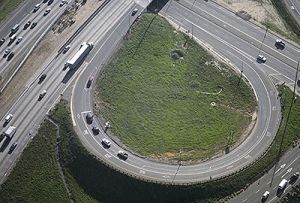

The following are to be classified as Ramp .
- Roads which connect roadways to other roadways as part of an interchange. This includes all freeway exits and entrances.
- Roads connecting freeways and highways with Rest areas, parking areas, and service plazas (e.g., "Exit to Service Area").
- Jughandles.
- Median U-turn Intersection (MUTI) and "Michigan left" segments.
- J-turn (RCUT/"Superstreet") segments.
- Displaced Left Turn (DLT) left turn segments.
The following are not to be classified as Ramp .
- At-grade connectors, unless they fit into one of the exceptions (see article).
- Turn lanes.
Ramp names do not appear on the client application map, but do appear in the text for routing directions. Entrance and exit ramps often contain a lot of text which is duplicative of roads already in the area, so this text is suppressed until the user actually needs it. This is also the reason for using the ramp type for named MUTI and jughandle segments—the text is needed for effective navigation instructions but would needlessly clutter the ramp.
Information on how to lay out ramps and set the proper angles from the main road can be found in the Junction Style Guide.
Streets


The Street types are for local and short-distance travel. Street types are used at the beginning and end of long routes as well.
Primary Street 
Collectors are roads used with medium-low traffic densities which are used to bring traffic from local streets to arterials and vice versa. Collectors are classified in Waze as Primary Streets.
Some states designate county routes which are important for travel within a county. These routes serve important functions in a short-distance capacity.
The following roads are to be classified, at minimum, as Primary Street :
- Roads classified in FHWA's functional classification as Major Collectors or Minor Collectors and paved with a hard surface.
- Signed, numbered county routes (and, in Louisiana, parish routes) paved with a hard surface.
- Business (BUS) and Loop state highways, and Spur state highways which are not used as connectors, paved with a hard surface.
- Frontage roads which serve as the means of access between freeways/expressways and surface streets, if not otherwise classified.
- Some functional classification maps are not produced in high enough detail to determine the class of frontage roads. On maps that are produced in high detail, frontage roads are almost universally classified as Major Collectors or higher.
Unpaved roads – including gravel, macadam, and dirt roads – are considered on a regional basis. Check your state page or contact your regional coordinator.
Note: Some states or counties may designate county routes differently than others. Check your state's page for possible exceptions to this rule.
As stated above, frontage roads should generally be set to at least Primary Street , if not marked as a higher type on a functional class map.
Many frontage roads are used as "feeder roads" or "access roads", often the primary or only means of entering and exiting a freeway. Setting these to the "street" type, as has been done in the past, has the potential to invalidate good routes which use freeways and major/minor highways. To ensure that routing works, always use at least "primary street" for frontage roads that are used in this way. It may be desirable to set the entire frontage road to the same type to achieve a more contiguous map appearance.
Street 

- Any road for public travel which does not meet the criteria for any other type shall be classified as a Street . Shown as "local roads" in some functional classification maps; not shown at all in others.
Service Road 
| The Service Road type is deprecated. Do not use the Service Road type for any purpose. |
Quick reference chart
Refer to this chart to determine the road type of a given paved public road based on the functional class.
To use this chart, first determine the functional class of a road, and whether it is a signed, numbered highway in a particular highway system.
Where the column for the road's highway system and the row for the road's functional class meet, you will find the proper road type for that particular road.
A number of examples are given below the chart.
| Highway Systems | |||||||||
|---|---|---|---|---|---|---|---|---|---|
| Interstate | Interstate Business Loop/Spur | US Hwy (incl. some special routes) | US Hwy BUS, SPUR, LOOP | State Hwy (incl. some special routes) | State Hwy BUS, SPUR[a], LOOP | County Route | Locally-maintained | ||
| example | I-10 E | I-94 Business | US-190 | US-460 Business | SR-23 | SR-400 Loop | CR-15 | Robertson St | |
| F u n c t i o n a l C l a s s |
Interstate[b] | Fw | n/a | n/a | n/a | n/a | n/a | n/a | n/a |
| Other Freeway[c] | n/a | Fw | Fw | Fw | Fw | Fw | Fw | Fw | |
| Other Expressway[d] | n/a | Major | Major | Major | Major | Major | Major | Major | |
| Other Principal Arterial[e] | n/a | Major | Major | Major | Major | Major | Major | Major | |
| Minor Arterial[f] | n/a | Major | Major | Minor | Minor | Minor | Minor | Minor | |
| Major Collector | n/a | Major | Major | Minor | Minor | PS | PS | PS | |
| Minor Collector | n/a | Major | Major | Minor | Minor | PS | PS | PS | |
| Local/not mapped | n/a | Major | Major | Minor | Minor | PS | PS | Street | |
^a When a state highway "SPUR" route is used to connect a state highway with another state highway, a US highway, or an Interstate (i.e., when it is used as a connector/CONN route), use the first state highway column.
^b Also known as Principal Arterial - Interstate.
^c Also known as Principal Arterial - Freeway.
^d Also known as Principal Arterial - Expressway.
^e Also known as Principal Arterial.
^f Also known as Other Arterial.
For example,
- An Interstate Business Loop classified as a Minor Arterial is a Major Highway .
- A US Highway classified as a Minor Arterial is a Major Highway .
- A US Highway Spur route classified as a Minor Arterial is a Minor Highway .
- A State Highway classified as an Other Freeway is a Freeway .
- A State Highway classified as a Collector is a Minor Highway .
- A County Route classified as a Minor Arterial is a Minor Highway .
- A County Route classified as a Collector is a Primary Street
- A locally-maintained road classified as an Other Principal Arterial is a Major Highway .
- A locally-maintained road classified as a Collector is a Primary Street .
| Fw | Freeway |
| Major | Major Highway |
| Minor | Minor Highway |
| PS | Primary Street |
| Street | Street |
Other drivable roads
Dirt Road / 4X4 Trail
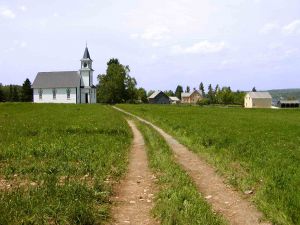
Generally, a road that is not paved.
Roads of the "Dirt Road / 4X4 Trail" type will not be used if the user has selected the "Don't allow" option in the client, and segments longer than 300m will be avoided if the user has selected "Avoid long ones".
In some areas of the country, improved unpaved roads (gravel, macadam, etc.) are set to this type. In other areas, improved unpaved roads, and possibly certain dirt roads, will be set to other types, as if they were paved. Check your state page or contact your regional coordinator for further guidance.
Parking Lot Road
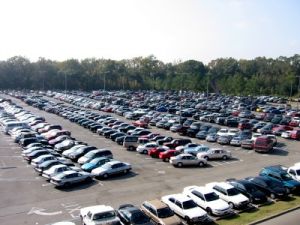
Parking lots, along with other publicly accessible roads such as alleys that should not be used for traffic routing unless directly at the start or end point of a route.
- Do not map the rows within parking lots because it clutters the map. See this additional page for more details on how to map parking lots.
| This section was updated as of January 14, 2015[update] to clarify when to use PLR vs Private Roads. |
- Use Parking Lot road type for all necessary segments in the Parking Lot.
- Parking Lot road type should be used inside Apartment Complexes, Trailer Parks, Schools, and Universities unless it meets the criteria for Private Road found in the next section below.
- Parking Lot roads have a transition penalty when exiting the Parking Lot road segment. This should prevent Waze from routing you through a Parking Lot or an alley as a shortcut.
- The proper use of parking lot roads can also help to avoid automated traffic jam reports as well as Map Problems related to Wazers driving in unmapped parking lots. Draw in the drivable portions of the parking lot that are near streets and other roadways. This will prevent the Waze routing server from assuming you must be on the main road when in fact you are stopped in the parking lot.
Additional information on this topic can be reviewed in the forums.
Information on mapping a parking lot landmark "place" is covered here.
Private Road
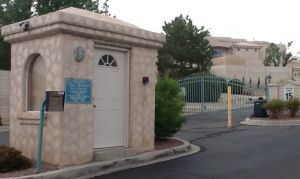
Private roads are useful for the following situations:
- Gated communities with controlled access
- Schools and Universities (gates / guard)
- Businesses with controlled access (gates / guard)
However, using private roads in some of these situations may require more complex mapping as covered in the article Private Installations. Be sure to read through that article before setting a whole neighborhood to all private roads.
As with Parking-Lot Roads, a route over a Private Road will incur a transition penalty upon leaving it for another road type. This transition penalty keeps Waze from routing Wazers through a private area as a shortcut. Unlike Parking-Lot Roads, however, Private Roads do not suppress automated traffic-jam detection.
As of August 2014[update] the Waze client displays Private Roads identically to public roads. Since this may change in future releases, never use the Private Road type for unrestricted public roads. Do not use the Private Road type as a workaround to force Waze to avoid slow public roads, for example those with rough patches or construction. In special cases, however, the Private Road type may be used for a public street that is legally and enforceably signed for local traffic only.
Non-drivable roads
Your car should not be here!
- These may be useful for points of reference when navigating such as seeing on a map where a turn is in relation to a railroad crossing.
- When Waze users travel on a non-vehicle route such as a bicyclist or mass-transit rider, marking these routes can be useful to explain the GPS traces that result.
- If a base map scan has non-drivable routes on it, it is important to mark these to prevent traffic routing onto them.
- Non-drivable road type of Walking Trail, Pedestrian Boardwalk, Stairway and Runway/Taxiway should not have any type of junction with a drivable road. Because of the way the routing engine uses a penalty system, Waze will route users to drive on these "Non-drivable" road types if they are connected to drivable roads. When crossing a drivable road, the non-drivable road should be bridged across without a junction between them and set at a different Elevation.
- It is OK to junction drivable roads with the Railroad type. See specific details in the Railroad section later on this page.
- Walking Trails, and other non-drivable road type which are visible in the app, can cause significant routing issues. If a walking trail (even when not connected to any other drivable segment) is closest to the latitude and longitude of the search result, the routing server will route you to the spot on the segment closest to that walking trail.
In the sketch below, if you assume the Place target is a latitude and longitude returned by a Google search result, you would think that the actual destination would be the parking lot segment because it is the closest reachable/connected segment to the target. But it won't be. The actual destination will be where the green spot is, because the closest segment to the latitude and longitude is the walking trail, and the closest Waze can route to the walking trail is to where the green spot is.

Emergency Vehicle and DOT Service Roads 
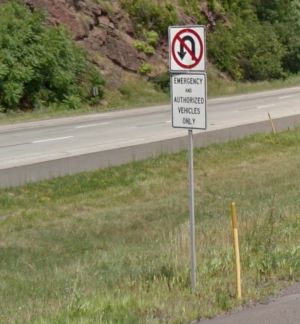
"Emergency and Authorized Vehicles Only" and DOT Service Roads are to be treated as Non-drivable roads. These are found primarily through the median of divided highways to connect opposite direction lanes. If mapped, they should not be connected to any drivable road, with properties set to road type Private Road, and lock the segment at as high a rank as possible, up to rank 5.
Walking Trails
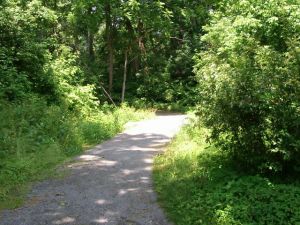
| This section is new as of May 24, 2015[update]. For details, please see the forum discussion. |
Use Walking Trails only with assistance from an expert in Walking Trails. They should only be used in rare cases. Walking Trails may have strange side effects on nearby routing. Never use the Walking Trail road type for ordinary hiking paths or bike paths. Most hiking and bicycling paths should not be on the map at all.
The WME lists the Walking Trail road type as non-drivable. However, as of May 2015[update], Walking Trails are fully routable and even support Waze House Numbers. Waze treats them in some ways like "Dirt road / 4X4 Trail" but displays them differently. Historically, editors have disconnected Walking Trails to make sure Waze doesn't route drivers over them. This doesn't always work as desired. If a disconnected Walking Trail comes closer to a destination than any other road, Waze may route drivers to a location nearer to the Walking Trail than to the destination. This problem can be severe for Walking Trails passing close to many destinations in a dense neighborhood. Connected or not, the Walking Trail type should never be used where effects on local routing are not desired.
The name "Walking Trail" suggests that Waze wants to support pedestrians and cyclists. However, as of April 2015[update], Waze focuses on drivers of motor vehicles and has no plans to encourage or support any other application. In fact, pedestrians and cyclists using the Waze app may damage Waze. By Wazing at speeds different from nearby traffic, they can create false traffic indications and even influence Waze's records of average road and turn speeds.
Because of this effect, editors should not map Walking Trails, or any other road type, for the sole purpose of encouraging non-driving Wazers. See the descriptions of other non-drivable road types for recommended applications of those types.
If the GPS Points layer shows clearly that pedestrians and cyclists already use Waze on a path or trail that lies parallel to a drivable road, then, as of May 2015[update], the path may be mapped with a Pedestrian Boardwalk. Doing so will limit the damage these Wazers would otherwise cause to the road's speed data. Such paths should only be mapped once it is clear Wazers regularly use them.
Applications
In rare cases, connected Walking Trails can bring drivers to destinations where otherwise Waze might fail to offer the best route. For example:
- A concert pavilion in an urban park accessed by a pedestrian path from a distant parking lot.
- A train station reachable from either side of the tracks but with no drivable road across them.
- A destination addressed on a non-drivable footpath.
A connected Walking Trail may be used to route drivers to such destinations. If the Walking Trail goes through from one drivable road to another, ensure that outgoing turn restrictions are red to disallow through routing via the Walking Trail. Lock the Walking Trail as this is uncommon usage that may puzzle other editors.
Orientation or destination applications involving foot or bicycle paths that do not require routing, such as marking where an obvious bicycle path crosses a road or where a trailhead is located, should not use the Walking Trail type. Use Pedestrian Boardwalks, Stairways, or Point Places as appropriate.
Naming
If destinations are addressed using House Numbers on a Walking Trail, it is essential that the Walking Trail's name and city fields be set accordingly so that routing to the addresses will work. For other routing situations, Walking Trails should be named to alert drivers that they must leave their car. For example, a Walking Trail connecting the two sides of a train station may be named "Station Access Path".
Pedestrian Boardwalks 

Stairway 
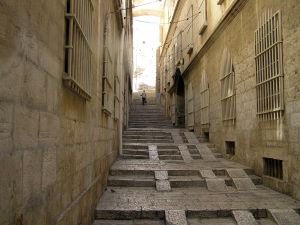
Railroad 
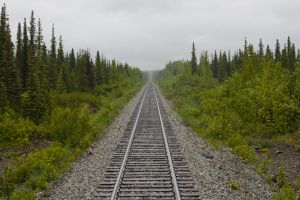
The "Railroad" road type serves two purposes in Waze. First, it provides drivers with visual orientation relative to railroad and light-rail tracks. More importantly, in the common case where passenger-carrying tracks lie parallel with roads, mapping the tracks allows Waze to recognize spurious speed data from people Wazing on the train and prevent it from corrupting speed data for the adjacent road.
The guidelines below which allow junctioning of railroads to drivable segments is new as of October 24, 2014.
|
Use the following guidelines when mapping railroad segments:
- By default, enter "Railroad" for the street name of every railroad segment. (See more below on Naming railroad segments.)
- Always select "None" for the city name. This avoids city smudging.
- Lock the segment at L2.
- Set the elevation just as you would a drivable segment. When tracks junction a road on the ground, the Elevation should be set to Ground.
- Create junctions between drivable roads and railroads.[rr]
- Set railroad to 2-way directionality
- Restrict turns to and from the railroad segments.
- When mapping railroad tracks, focus on those near drivable roads.
- Map rail yards simply, with one railroad segment along either edge of the yard's tracks.
- Map industrial spurs only if they cross drivable roads.
- Do not map every piece of parallel track, such as in sidings or yards, or industrial spurs that don't cross any roads. Your work may otherwise be seen as clutter, much like mapping every parking lot row.
- Multiple parallel lines at crossings:
- At most crossings, there should be only one railroad segment mapped and no more than two parallel railroads mapped at any crossing.
- Parallel lines are to be at least 5m apart
- In general, there is no reason to have multiple lines mapped. When not at a crossing, even four parallel lines can be easily mapped as a single railroad segment in Waze.
- Keep segment lengths under 10,000 meters – the longer the segment length, the more sluggish the editor is to respond to changes.
- Do not map railroads using a drivable road type (streets, primary streets, etc.); it could be a hazard to human life if drivers were routed to them.
^rr Note: The routing server will properly account for delays at railroad crossings through a segment without a junction. However, with a junction, the historical data for the rail crossing will be more accurate.
Use the following guidelines when naming railroad segments:
- For commercially-controlled right-of-ways, rather than apply the default "Railroad" name, you may optionally use the owner's full legal name spelled out without acronyms or abbreviations (e.g. "New Orleans Public Belt Railroad"). Some owners' names incorporate what appear to be or once were acronyms but are actually part of the legal name (e.g., "BNSF Railway", "CSX Railroad").
- In case of uncertain ownership, do not guess. Use the default "Railroad" name.
- Do not name a railroad segment for a passenger operator that uses it, regardless of how many passengers or how little freight it may carry, unless you are absolutely certain that the passenger operator owns the track. For example, do not name a segment "Amtrak" unless Amtrak actually owns the track (it usually does not, except in the Corridor and in a few other areas).
- Do not apply "fallen flags" (former owners that no longer exist due to bankruptcy or merger) in the alternate field.
- Keep in mind that should the name of the owner change, due to bankruptcy, merger, or other business decision, you or another editor will need to come back and fix all now-incorrect segments. Railroads can change names often; for example, BNSF Railway has been known by that name only since 2005, and its previous name was in use for only eight years.
- For urban rapid transit and light rail systems, rather than apply the default "Railroad" name, you may optionally use the name of the transit authority and the name of the line, separated by a hyphen (e.g., "MBTA - Green Line", "RTA - Riverfront Streetcar").
- If a system has only one line, of course, use its name alone (e.g., "Detroit People Mover").
- If multiple lines share the same track or run on parallel tracks, include all lines (e.g., "Metro Rail - Red/Purple Lines").
- However, if a rapid transit system is so complex that including all line names would lead to an absurd result on some railroad segments, use the name of the system alone (e.g., "BART", "MTA") throughout the system.
- Federal DOT Railroad GIS: http://fragis.fra.dot.gov/Apps/GISFRASafety/
Waze - Support
Railroads should be labeled as such in the editor. For the time being they won't make it to the client indeed, but in the future we might want to use them for display purposes.
The "railroad" road type in the editor is under "non drivable" so it should not cause any issue to the routing.
For specific recommendations in other countries outside the United States, please see the entry for the country in question here.
Runway/Taxiway
Airport runways and private airstrips may be mapped using the Runway/Taxiway road type. The Runway/Taxiway type is for display only and must never connect to drivable road segments. If a drivable road and a runway cross, set the elevation of the road below that of the runway and ensure there is no connection. Draw each runway as a single segment and lock it to prevent lower-ranking editors from attaching a road. Do not form junctions where runways cross each other.
Name each runway using the airport identifier, the word Runway, and the runway designations with the lower number first (e.g., "SMF Runway 16R-34L".) The preferred airport identifier is the IATA 3-letter code, for example "SFO", "LAX", "JFK", etc. If the airport in question is not included in that list, use the ICAO 4-letter code instead. If the airport is not included in that list use the FAA identifier. For the "City" field of runway segments, check "None" to avoid any chance of city smudging.

Despite its title, the Runway/Taxiway road type should never be used for an aircraft taxiway because it would render the same as a runway and confuse the display. Taxiways not intended for frequent access by street vehicles should not be mapped at all with any road type. Taxiways that commonly serve street vehicles as well as aircraft, for example at fly-in communities, may be mapped as Streets provided they remain disconnected from any runway.
Ferry 
| The Ferry Road type is not to be used at this time. Do not use the Ferry Road type for any purpose. See ferries page for more information on how to map ferries. |
Roundabouts 

Roundabouts have few principals:
The first one, each node on the roundabout can only be connected to no more than one segment.
Each connection has a spectrum that exists in order to notify the Client on how to define the message (Go straight, exit through the 2nd / 3rd / 4th exit).

The system will include the radius border from the center and notify the user accordingly.
For more information on when to create a Roundabout or a loop instead, please review the Junction Style Guide.
For information on what type of road to set a Roundabout to, please review Creating and Editing a Roundabout
Special case roads not covered
There are a number of other types of roadways and lane types which are not directly covered with the current options above. In some cases there are plans to add some of these special cases, but in the mean time the following guidelines are the best that can be done with the current settings.
Bus or cab only lanes
When a road or lane is designated for bus or cab use only, mark that road segment(s) as a Private Road to prevent the Waze router from using that segment(s) for general traffic, since the majority of the users will not be able to use that lane. It is also advisable to set the turn restrictions to prevent turns into that segment(s), but permit turns exiting the segment.
If a road is one-way, but allows bus or cab traffic to flow the other direction, leave the road as one-way with the normal flow of traffic. There is no need to create a second road traveling the opposite direction for the bus and cab-only traffic.
Driveways
Most urban communities have very short driveways between the named road they live on and the garage or carport on their property. In general these very short segments should not be mapped because they have no name, would clutter the map in the client app, take a lot of time to draw, and would greatly increase the overall size of the Waze mapping database with very little return.
In the case of very long driveways, it may helpful to a driver to see the driveway mapped on the client app or even necessary for Waze to determine how to reach the destination. In those cases it may be prudent to add a road. See the article on Driveways for more information.